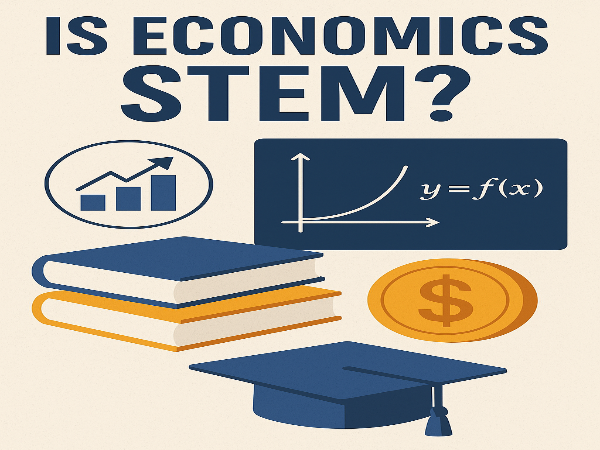Is Economics STEM? Understanding the Classification, Scope, and Relevance in Modern Education
Exploring How Economics Bridges Social Science and STEM Disciplines

“Is economics STEM?” is a question that sparks debate among students, educators, and policymakers worldwide. Traditionally, economics has been viewed as a social science—a field that studies human behavior, markets, and decision-making. However, in recent years, the discipline has evolved dramatically, integrating mathematics, statistics, data analysis, and computational models. This transformation has led many to reconsider economics as a STEM (Science, Technology, Engineering, and Mathematics) subject, particularly in universities that emphasize quantitative and analytical approaches. Understanding where economics fits into the STEM landscape is crucial for students choosing their academic path and for institutions shaping future-ready curricula.
What Is STEM?
Before defining where economics fits, it’s essential to understand what STEM truly represents. STEM stands for Science, Technology, Engineering, and Mathematics, encompassing disciplines that rely on empirical reasoning, quantitative analysis, and experimental validation. These fields are the foundation of innovation and economic growth, emphasizing technical skills, data-driven thinking, and problem-solving.
STEM subjects are characterized by measurable outcomes, the use of mathematical and scientific methods, and an emphasis on evidence-based conclusions. Traditionally, these include physics, biology, chemistry, computer science, mathematics, and engineering—but the modern educational and professional landscape has expanded this list to include fields that apply quantitative tools, like data analytics, econometrics, and even certain branches of psychology or geography.
Economics: A Social Science with Quantitative Roots
Economics has long been classified under the social sciences, alongside sociology, political science, and anthropology. It studies how individuals, institutions, and nations allocate limited resources to meet human wants and needs. However, unlike many other social sciences, economics is heavily grounded in quantitative reasoning.
Modern economics applies mathematical models to predict outcomes, test hypotheses, and evaluate policies. From microeconomic consumer theory to macroeconomic forecasting, the discipline uses tools such as calculus, linear algebra, statistics, and econometrics. This analytical foundation bridges the gap between social sciences and STEM fields, making economics unique in its dual nature—both qualitative and quantitative.
Why Economics Is Sometimes Considered STEM
The classification of economics as a STEM subject depends on how it is taught and structured. Many universities, especially in the United States, have reclassified certain economics programs under the STEM category due to their mathematical rigor and data-driven methods.
For instance, programs titled “Econometrics and Quantitative Economics” are recognized as STEM disciplines under the U.S. Department of Homeland Security’s Classification of Instructional Programs (CIP) code 45.0603. These programs emphasize statistical modeling, computational analysis, and empirical research—core aspects of STEM education.
In contrast, general economics degrees (coded as 45.0601) that focus more on theory and policy without extensive mathematical training often remain classified as social sciences.
The growing overlap between economics and data science, machine learning, and computational modeling further supports the STEM classification. Economists now work with large datasets, predictive algorithms, and statistical software—skills traditionally associated with STEM professionals.
Mathematics and Statistics: The Core of Modern Economics
Mathematics is the language of modern economics. From optimization in production theory to regression analysis in econometrics, mathematical tools are essential to formulating and testing economic ideas.
Key areas where math defines economics include:
-
Microeconomics: Uses calculus and algebra to model consumer and producer behavior.
-
Macroeconomics: Employs differential equations and statistical analysis for growth models and monetary policy simulations.
-
Econometrics: Relies on advanced statistics to test hypotheses and forecast economic trends.
-
Game Theory: Applies mathematical logic to understand strategic decision-making.
Because of this deep mathematical integration, many universities and employers now view economics as a STEM-compatible field, especially when the curriculum focuses on quantitative skills.
The Debate: Is Economics Truly STEM?
Despite its mathematical depth, there’s an ongoing debate about whether economics should be universally considered a STEM subject. Critics argue that economics still centers on human behavior, institutional analysis, and policy—areas that depend on qualitative judgment as much as quantitative modeling.
Supporters, however, counter that the discipline’s reliance on data analytics, econometric software, and mathematical modeling aligns it more closely with STEM. In practice, the distinction often lies in curricular emphasis rather than the discipline itself.
For example:
-
A Bachelor of Arts (BA) in Economics may emphasize theory, history, and social context.
-
A Bachelor of Science (BS) in Economics may stress mathematics, statistics, and computing—qualifying as a STEM program.
This dual nature allows economics to serve as a bridge between the humanities and the sciences.
Global Perspective on Economics as STEM
Globally, the classification of economics varies by country and institution.
-
United States: Many universities have reclassified quantitative economics as STEM to allow international students to qualify for extended work opportunities (OPT extensions).
-
United Kingdom: Economics is generally listed under the social sciences, though quantitative economics programs blur this line.
-
Canada and Australia: Universities increasingly market economics as a STEM-related field due to its analytical and technical orientation.
-
Asia (including Pakistan and India): Economics is typically categorized under social sciences, but programs emphasizing econometrics or mathematical economics are gaining recognition as STEM-compatible.
This variation underscores that the classification depends less on the subject itself and more on how it’s taught and applied.
Career Advantages of Studying Economics as a STEM Field
When economics is recognized as STEM, it offers several advantages for students and professionals alike:
-
Broader Career Opportunities: STEM-designated economics graduates can pursue careers in data science, financial analysis, policy modeling, and AI-driven research.
-
Visa and Work Benefits (in the U.S.): International students in STEM programs can apply for a 24-month Optional Practical Training (OPT) extension, increasing employability.
-
Higher Employability: Quantitative economics programs develop in-demand skills like coding (Python, R), data analytics, and statistical reasoning.
-
Cross-Disciplinary Relevance: Economics with a STEM foundation fits perfectly within tech-driven industries, consulting firms, and research organizations.
-
Adaptability: The analytical mindset nurtured in STEM economics helps graduates excel in diverse fields—from finance to policy and technology.
STEM Skills in Economics Education
To understand why economics increasingly fits within STEM, consider the specific skills students gain through quantitative economics programs:
-
Mathematical Modeling: Translating real-world economic problems into equations for analysis.
-
Statistical Analysis: Using probability, inference, and regression to interpret data.
-
Computational Skills: Applying coding languages and data software for simulations and visualizations.
-
Analytical Problem-Solving: Framing and testing hypotheses with empirical data.
-
Critical Thinking: Combining logic with evidence-based reasoning to make policy or business decisions.
These competencies align with core STEM learning outcomes, showing that economics has evolved far beyond theoretical social science.
Economics, Data Science, and Artificial Intelligence
The rise of data science and artificial intelligence has further blurred the lines between economics and STEM. Modern economists analyze vast datasets to uncover trends in consumer behavior, financial markets, and macroeconomic conditions.
Machine learning techniques, such as predictive modeling and clustering, are increasingly applied to economic forecasting and policy analysis. Economists now collaborate with computer scientists and engineers to design algorithms for real-time market predictions and financial technology innovations.
This integration makes economics an essential part of the STEM innovation ecosystem, where data, computation, and theory converge to drive decision-making.
Why Some Universities Have STEM-Designated Economics Programs
Many top universities have restructured their economics departments to meet the standards of STEM designation. This reclassification is not merely administrative—it reflects a fundamental shift in the discipline’s focus toward analytics and computation.
The change benefits both institutions and students:
-
Universities attract more international students and align their curricula with global job market demands.
-
Students gain access to extended work permits, research funding, and industry collaborations in technology and finance.
This trend highlights a growing recognition that economics is as technical and data-driven as many established STEM disciplines.
The Future of Economics in STEM Education
The future of economics lies at the intersection of data analytics, technology, and behavioral science. As global economies digitize, economists play an increasingly vital role in interpreting data, designing algorithms, and guiding evidence-based policy decisions.
Universities are expected to continue integrating economics with computer science, mathematics, and artificial intelligence—creating hybrid degrees like “Quantitative Economics,” “Computational Economics,” or “Data Analytics and Economics.”
These interdisciplinary programs will not only redefine how economics is taught but also solidify its place within the broader STEM framework.
Conclusion
So, is economics STEM? The answer depends on how the discipline is approached. At its core, economics remains a social science, focused on understanding human choices and market behavior. Yet, its modern form—rich with mathematics, statistics, and computational modeling—positions it firmly within the STEM family.
In today’s data-driven world, economics is no longer confined to theoretical debates; it’s a scientific, analytical, and technology-oriented field that shapes industries and policies. Whether classified as STEM or social science, one thing is clear: economics equips learners with the critical thinking, quantitative reasoning, and problem-solving skills essential for the future.



